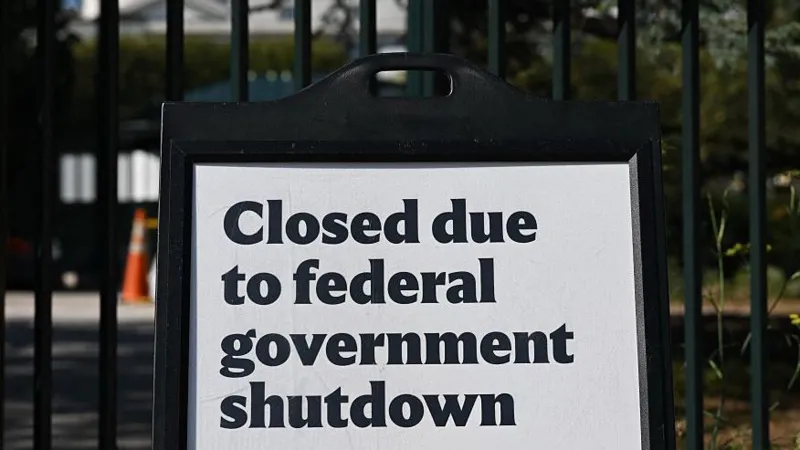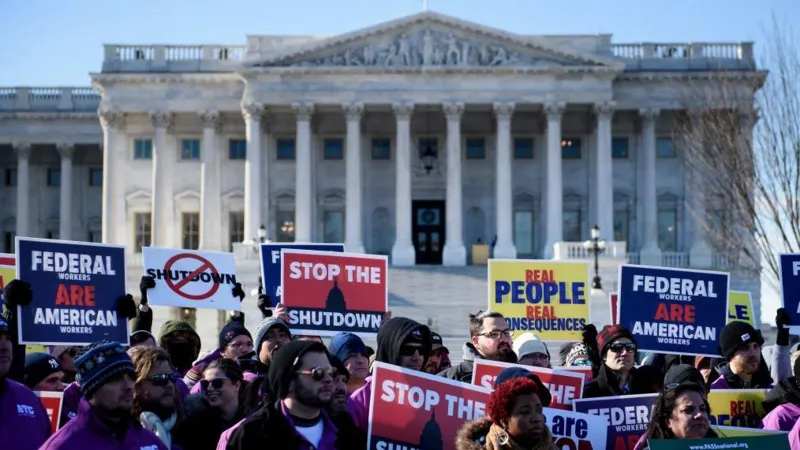The US government shutdown has entered its third week, with Republican and Democratic politicians no closer to an agreement on how to resolve an ongoing budget dispute.
It means that some, but not all, US government services are temporarily suspended, and around 1.4 million federal employees are on unpaid leave or working without pay.
Although budget confrontations are common in US politics, this spending fight is especially tense because President Donald Trump has drastically reduced the size of the national government since taking office, and has suggested he may use the current impasse to make further cuts.
The Trump administration has already moved to lay off about 4,000 workers as the shutdown continues, though that was temporarily blocked by a federal judge on Wednesday. The White House has said it will appeal that ruling.
Why did the US government shut down?
The shutdown happened because Republicans and Democrats could not agree to pass a bill funding government services into October and beyond.
Under the US system, the different branches of government have to reach an agreement on spending plans before they can become law.
The Republicans currently control both chambers of Congress. But in the Senate – or upper chamber – they are short of the 60 votes needed to pass the spending bill, which gives opposition Democrats some negotiating power.
They want to see an extension of expiring tax credits which make health insurance cheaper for millions of Americans, and for a reversal of Trump’s cuts to Medicaid, a government healthcare programme used by millions of elderly, disabled and low-income people.
Democrats also oppose spending cuts to government health agencies.
A stopgap bill designed to avoid the shutdown was passed in the House, or lower chamber, but did not clear the Senate.
And so, at 00:01 EDT on 1 October (04:01 GMT), the US government had its first shutdown for nearly seven years.
Which services have stopped, and which are continuing?
Not all aspects of government stop during a shutdown. Services deemed essential continue as normal, although in many cases staff are not paid for the duration of the suspension.
Border protection and law enforcement staff, Immigration and Customs Enforcement (ICE) agents, and in-hospital medical care workers are expected to operate as usual.
However thousands of flights have been cancelled or delayed because of a shortage of air traffic controllers, who are also expected to work without pay.
US troops were on track to miss their first paycheck on Wednesday, but the Trump administration said it had “identified funds” to keep them paid.
Speaker of the House Mike Johnson, however, has warned that this is a “temporary fix” and that troops risk missing their next paychecks if the shutdown continues.
Social security and Medicare cheques are still being sent out, although benefit verification and card issuance work may stop.
Government employees deemed non-essential have been furloughed – temporarily put on unpaid leave. Contractors who work for federal agencies but are not directly employed by the government are missing out on work, too.
Several agencies, like the Centers for Disease Control and Prevention (CDC) and the National Institutes of Health (NIH) have also furloughed many workers, affecting ongoing research projects.
Services like the food assistance programme and federally-funded pre-school and institutions like the Smithsonian museums have been reduced or closed. Some major national parks and monuments across the country have closed, including Alcatraz Island in the San Francisco Bay Area and the Independence National Historical Park in Philadelphia, according to government websites.

The interior of the Washington Monument has also closed, as have the Smithsonian museums and the National Zoo.
During the previous shutdown between December 2018 and January 2019, National Parks were kept open with no staff, which led to vandalism and looting at a number of historical sites.
Mail is still being delivered and post offices are open because the US Postal Service does not depend on Congress for funding.
Most American schools are state-funded, but the federal government is responsible for billions of dollars in grants and student loans, which could effectively come to a halt.
However, because the grants are typically awarded during the summer, schools are expected to be largely unaffected during this shutdown, according to the education secretary.
Members of Congress are still being paid, a convention that has been criticised by some politicians.
How has the White House responded?
In the past, lengthy government shutdowns were usually seen as politically dangerous, hampering voters’ everyday lives and the reputation of lawmakers and the president.
After previous shutdowns were resolved, government operations mostly returned to normal, with staff receiving back pay for the period, and government spending largely going back to previous levels.
However this time, the White House appears more than happy to shutter large parts of the US government for an extended period.
Over the past nine months the Trump administration has slashed government spending and sacked many federal workers, testing the boundaries of presidential power.
Officials have threatened to use the shutdown to identify more “non-essential” workers who could be permanently let go.
“We’ll be laying off a lot of people,” Trump said on 30 September, the day before the shutdown began.
The administration has also warned that furloughed “non-essential” workers may not receive their unpaid salary after the shutdown finishes.
On 7 October, Trump told reporters that back pay “depends on who we’re talking about” and that some workers “don’t deserve to be taken care of”.
Many lawmakers insist this is wrong, including the top Democrat in the US House of Representatives, Hakeem Jeffries, who said: “The law is clear – every single furloughed federal employee is entitled to back pay, period.”
Trump’s comments were made the day after the Senate failed for a fifth time to pass the spending measures that would allow government to resume.
Neither of the competing proposals put forward by Democrats and Republicans received enough votes.

How long will the shutdown last?
It is difficult to say. In this case, it really depends when – or if – either of the parties will agree to a compromise.
The Republicans could negotiate an extension to the healthcare subsidies demanded by the Democrats.
Alternatively the shutdown could become so disruptive that the Democrats decide to back down and agree to fund the government – at least temporarily – to get things up and running again.
So far, the Trump administration has been unwilling to offer substantive concessions. It believes the Democrats will bear the brunt of the public’s blame because it argues the party’s demands caused the shutdown.
Meanwhile the Democrats believe their efforts to secure cheaper healthcare are popular.
The party’s congressional leaders provoked the ire of some left-wing activists for backing down during the last budget dispute in March.
Many Democrats seem to be itching for a bigger fight this time around – and funding the government is one of the only places where the party has some leverage.
Democratic House Minority Leader Hakeem Jeffries has so far signalled that his party will not budge and that it is up to Republican lawmakers to negotiate.
“House Republicans shut the government down, then they ran out of town. And for the last three weeks, they’re nowhere to be found,” he said on Wednesday.
In the Senate, Republican Majority Leader John Thune told reporters on Wednesday that both parties are “dug in” on their positions.
Later that day, a measure to fund the government until 21 November failed to pass in the Senate for the ninth time since the shutdown began.
How could the shutdown affect the economy?
The scale of the damage will depend in part on how long the shutdown lasts – and how wide ranging it is.
Analysts estimate it could shave roughly 0.1 to 0.2 percentage points off economic growth for each week that it continues – although much of that could be recouped, as has happened after previous shutdowns.
That relatively muted impact may be why the stock market seems to be shrugging off this latest threat.
But if Trump ends up firing workers, rather than temporarily putting them on furlough – or doesn’t pay a substantial portion of them – the impact could be more substantial.
The US economy has already been hit by the effects of Trump’s tariffs, with the likely delay of key data – such as the official US monthly jobs report – expected to add to the uncertainty.
What happened during previous shutdowns?
Shutdowns over budgets are a unique aspect of US politics.
They have become quite common over the past 50 years – with three taking place during Trump’s first presidential term.
The last shutdown which began in late December 2018 lasted 35 days – the longest in history.
It was brought about by disagreements over funding a wall on the Mexico border.
It finally ended in part because large numbers of air traffic controllers, who had been working for a month without pay, began calling in sick, as has started to happen during the current shutdown.
At the time, flight disruption quickly spread, and the shutdown came to an end shortly afterwards.
The Congressional Budget Office (CBO) estimated that the 2018-2019 shutdown reduced economic output by about $11bn, including $3bn that it never regained.
But shutdowns pre-date Trump.
The second longest to date was 21 days, under Democrat President Bill Clinton in 1995. His fellow Democrat Barack Obama had a 16-day shutdown during his time in the White House, and Republican Ronald Reagan oversaw eight shutdowns during his presidency in the 1980s – though all were relatively brief.

Also read: US shutdown continues after Senate fails to pass funding bills
For more videos and updates, check out our YouTube channel


